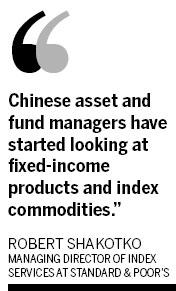BEIJING: A variety of investment instruments will eventually be common in China as retail investors gain the sophistication of investing in different asset classes, and capitalizing on opportunities outside of the country, said Robert Shakotko, managing director of Index Services at Standard & Poor's (S&P). 
"Chinese asset and fund managers have started looking at fixed-income products and index commodities," he said. "More Chinese investors are aware of global opportunities when they look for equity investments. When they invest in (the equity stocks of) the Coca-Cola Company, for example, they also invest in the company's global activities."
Shakotko was speaking to the media recently following the licensing of the S&P 500 Index on March 18 to Bosera Asset Management Co, a Chinese mutual-fund company, for the development of an exchange-traded fund (ETF) based on the index.
The licensing move to Bosera is considered significant to the investment community as 10 years ago nobody in China could imagine engaging in trade outside of the country, he said.
As of the end of 2009, Bosera had 209 billion yuan ($30.62 billion) worth of assets under management, the company's website said. China, and the rest of the Asia-Pacific, remain important strategic markets for S&P to expand its international business.
Shakotko reckoned the first ETF in China would eventually lead to the introduction of other indexes such as different types of bonds and commodities, which are popular in Europe.
However, the main challenge facing the investing community today is the fear of investing after the recent financial crisis.
"After a period of crisis, there will be a period of fear," Shakotko said. "The immediate instinct is to cash out and deposit whatever remains in a safety box. This is the fear that we need to overcome."
Reestablishing a long-term investment strategy would be an immediate, crucial task of fund managers and investors.
"Out of every crisis come profound changes. That the old way of doing things and old companies have disappear, investors now need to identify new companies and new opportunities," he said.
New opportunities include companies running technology, mineral resources and the financial businesses.





